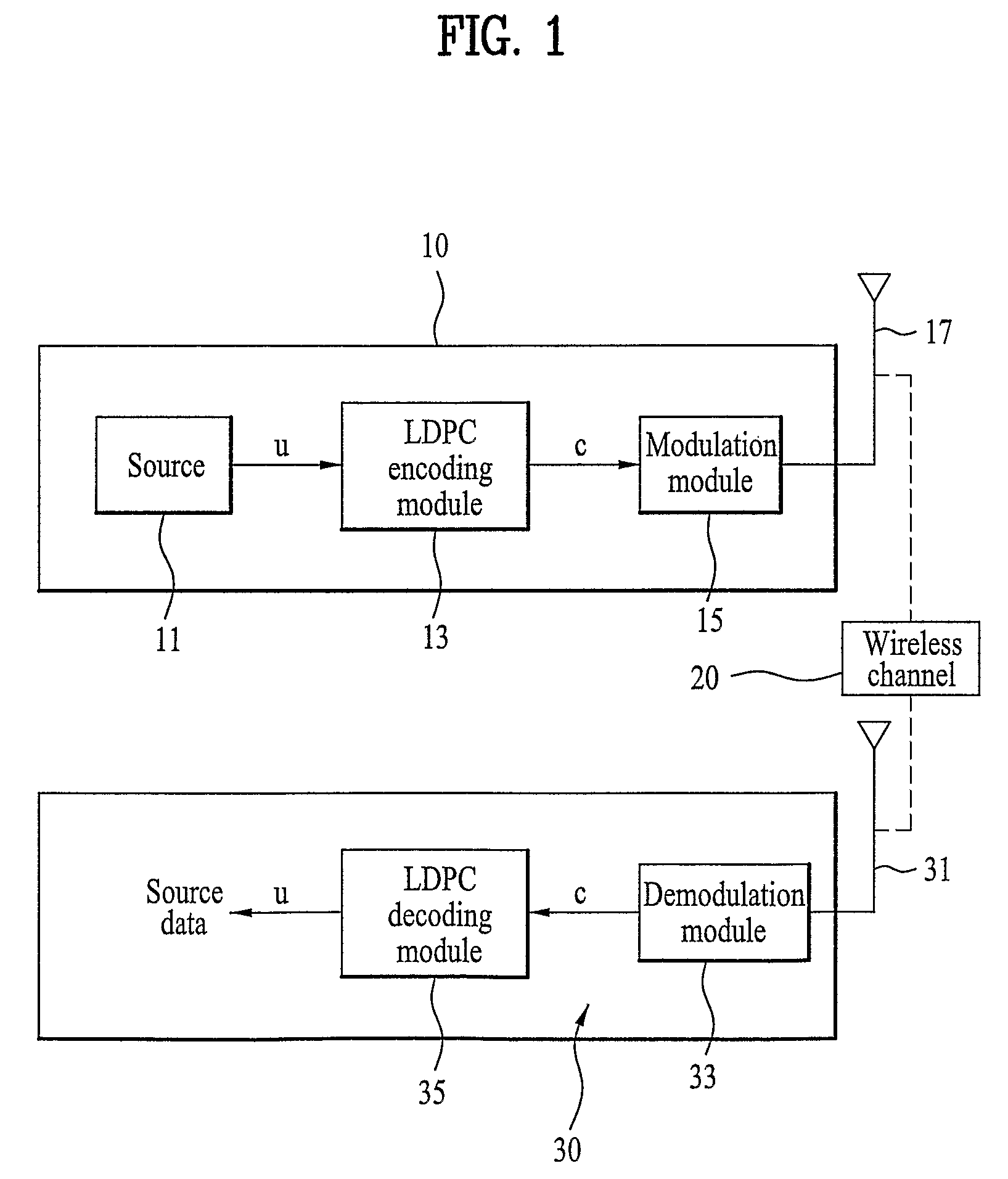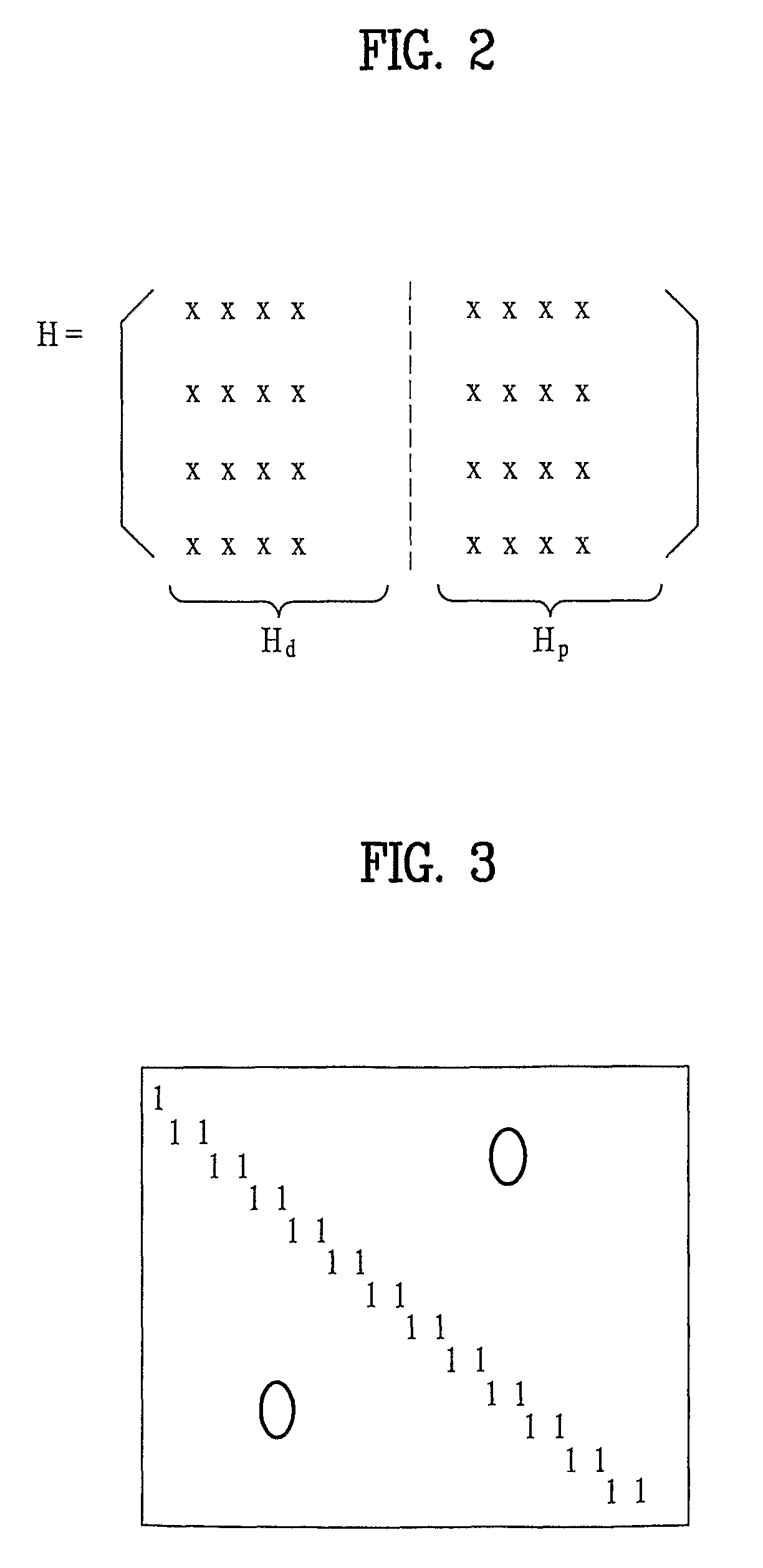Method of encoding and decoding using low density parity check code
a low density parity check and encoding technology, applied in the field of encoding and decoding, can solve the problems of large storage space for difficult to implement ldpc code that is very complicated, and the parity check matrix h needs a large storage space, so as to reduce the amount and complexity of calculation necessary for encoding or decoding and enhance the performance of encoding or decoding.
- Summary
- Abstract
- Description
- Claims
- Application Information
AI Technical Summary
Benefits of technology
Problems solved by technology
Method used
Image
Examples
first embodiment
[0047]In a first embodiment, in case of dividing the Hd into m sub-matrices of (n−k) / m×k dimensions, a jth row of one specific sub-matrix of the m sub-matrices the Hd having consecutive ‘1’ amounting to the number of Wj (j=1, 2, . . . , (n−k) / m) on condition that each column weight of the specific sub-matrix is ‘1’. The Wj can be identical to the entire rows of the specific sub-matrix. And, the Wj can irregularly increase or decrease for the entire rows of the specific sub-matrix.
[0048]FIG. 4 and FIG. 5 are diagrams to explain the first embodiment in detail and show examples of the specific sub-matrix included in the Hd.
[0049]The specific sub-matrix shown in FIG. 4 is a matrix having 7×28 dimensions. Yet, a substantial matrix used for LDPC encoding is much larger than the matrix of the 7×28 dimensions. In FIG. 4, each row of the specific sub-matrix has four consecutive ‘1’ and the rest values of the corresponding row are zero (i.e., a weight of each row is 4.) And, a weight of each ...
second embodiment
[0050]In the Hd having a predetermined regularity in row and column weights, the Hd includes r(1−r) matrices H(i)d [where r=k / n and i=1, 2, . . . , r / (1−r)] having (n−k)×(n−k) dimensions, a random H(i)d includes m×m sub-matrices each of which has (n−k) / m×(n−k) / m dimensions, and a row or column weight of the random sub-matrix configuring the Hd is 1.
[0051]The Hd can includes at least one H(i)d [where i=1, 2, . . . , r / (1−r)] according to a code rate (r=k / n). The code rate r is a ratio of a source data length k to a length n of the encoded data and r=1 / 2, 2 / 3, 3 / 4, 4 / 5 and the like is used in general. The H(i)d is a matrix having (n−k)×(n−k) dimensions and has a relation of Hd=[H(1)d|H(2)d| . . . |H(r / (1-r))d].
[0052]Each H(i)d is characterized in that a row or column weight of a random sub-matrix configuring the Hd is 1 in case of being divided by m×m sub-matrices each of which has (n−k) / m×(n−k) / m dimensions. The ‘m’ is a positive integer and corresponds to a resolution factor of the ...
PUM
 Login to View More
Login to View More Abstract
Description
Claims
Application Information
 Login to View More
Login to View More - R&D
- Intellectual Property
- Life Sciences
- Materials
- Tech Scout
- Unparalleled Data Quality
- Higher Quality Content
- 60% Fewer Hallucinations
Browse by: Latest US Patents, China's latest patents, Technical Efficacy Thesaurus, Application Domain, Technology Topic, Popular Technical Reports.
© 2025 PatSnap. All rights reserved.Legal|Privacy policy|Modern Slavery Act Transparency Statement|Sitemap|About US| Contact US: help@patsnap.com



